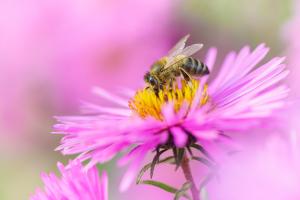In the same section
-
Share this page
ARC: research project CapTure
CapTure : Capillary Trapping and Slender Structure

Some nectar-feeding animals have ‘hairy’ tongues, shaped like a paintbrush. This is the case, for instance, of the bee, whose tongue hairs spread out when in contact with nectar. Little is still known about the role these hairs play in capturing the liquid; this project’s goal is to better understand the mechanisms at play.
The project intends to develop general theoretical models using analogous systems (artificial tongues) whose parameters (size and material properties) can be adjusted with precision, and models of fluids whose properties (viscosity, density) are known.
This will enable the researchers to determine how changing one parameter—such as tongue size, which varies between different species of bee, or nectar viscosity—affects the amount of nectar absorbed, which could help them understand why nectar-feeding animals have developed different types of tongue throughout evolution.
Predictions obtained from these models will be validated using measurements taken directly on the animals in question, in collaboration with biologists.
Coordination: Fabian Brau, Service de Chimie Physique et Biologie Théorique, Faculté des Sciences
